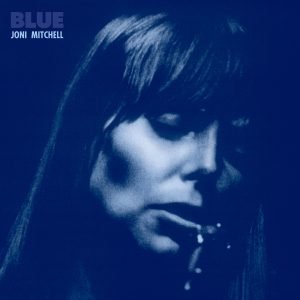Released in 1971, Joni Mitchell’s Blue stands as a cornerstone in the landscape of modern music, a touchstone of introspective songwriting and emotional candor. Situated within Mitchell’s discography, Blue marks a significant evolution from her earlier work. While her previous albums—such as Song to a Seagull (1968), Clouds (1969), and Ladies of the Canyon (1970)—already hinted at her burgeoning talent for intricate melodies and poetic lyricism, Blue dives deeper into personal reflection and raw vulnerability.
In the broader music landscape of the early 1970s, Blue emerged during a time when singer-songwriters were gaining prominence. The era was ripe with artists who were using their music as a means of personal expression and social commentary, but few did so with the same degree of intimacy and self-exposure as Mitchell. The album’s release coincided with the aftermath of the 1960s cultural revolution, a period characterized by a yearning for authenticity and deeper connection. In this milieu, Blue was both a product of its time and a timeless statement, resonating with listeners on a deeply personal level.
Artistic Intentions
Mitchell’s artistic intentions with Blue were ambitious and deeply personal. Through the album, she sought to explore and communicate her innermost experiences and emotions, covering themes of love, loss, and longing with an unflinching honesty. In interviews and album notes, Mitchell has spoken about the album as a form of therapy, a way to process her emotions and the tumultuous experiences she had undergone. She intended for the album to be a direct channel of her inner world, with each song serving as a diary entry set to music. This was a bold artistic choice, especially at a time when the music industry often favored more polished and less personal narratives.
From the haunting melancholy of the title track to the poignant storytelling of “A Case of You,” Mitchell’s Blue was designed to be an intimate conversation with the listener. It stripped away the layers of artifice to reveal the stark, beautiful core of human emotion. As such, the album not only expanded Mitchell’s own artistic boundaries but also set a new standard for what could be achieved through the medium of song. In doing so, Blue became a seminal work that continues to influence and inspire musicians and listeners alike.
Sonic Exploration

Production Quality
The production quality of Blue is both refined and intimate, perfectly complementing Joni Mitchell’s artistic vision. Produced by Mitchell herself, alongside engineer Henry Lewy, the album boasts a crisp and clear sound that enhances its emotional resonance. The production is minimalist, avoiding the lush orchestration or complex studio effects that were popular at the time. Instead, Mitchell’s voice and acoustic instruments take center stage, allowing the rawness of her lyrics and melodies to shine through. This choice of production style serves the album’s themes of vulnerability and introspection, creating a direct and unembellished connection with the listener.
Musical Arrangements
The musical arrangements on Blue are elegantly sparse, yet deeply evocative. Mitchell’s use of open tunings on the guitar provides a unique harmonic palette, adding a distinctive tonal quality to her songs. The album features a delicate interplay of acoustic guitar, piano, and dulcimer, with occasional contributions from other instruments. One of the most memorable arrangements is found in “River,” where Mitchell’s piano playing evokes the feeling of a flowing stream, mirroring the song’s themes of regret and longing.
Vocally, Mitchell’s performance on Blue is a masterclass in emotional expression. Her voice is both powerful and fragile, capable of conveying a wide range of emotions. In “A Case of You,” her vocal delivery is particularly poignant, capturing the bittersweet essence of the lyrics. The harmonies she crafts with herself, as heard in “All I Want,” add depth and texture to the arrangements without overpowering the simplicity of the instrumentation.
Genre Elements
Blue primarily resides within the folk genre, but it also incorporates elements of pop and jazz, creating a sound that is uniquely Mitchell’s. The album’s folk roots are evident in the acoustic guitar-driven tracks and the storytelling nature of the lyrics. However, Mitchell’s sophisticated chord progressions and melodic phrasing hint at her later forays into jazz, which would become more pronounced in her subsequent work.
The blending of these genres is done seamlessly, with Mitchell’s songwriting and vocal style providing a cohesive thread throughout the album. This genre-blending approach was innovative at the time, setting Blue apart from other folk records of the era. It allowed Mitchell to push the boundaries of what folk music could encompass, paving the way for future artists to explore similar sonic territories.
Lyrical Analysis

Themes and Messages
At its core, Blue delves into themes of love, loss, and self-discovery, exploring the intricacies of human emotion with unparalleled honesty. The album is often seen as a confessional work, where Joni Mitchell lays bare her soul, inviting listeners into her intimate world. Love, in its various forms, is a recurring motif throughout the album. Songs like “All I Want” and “My Old Man” express the yearning for connection and the complexities of romantic relationships. Meanwhile, “A Case of You” and “Blue” delve into the pain of heartbreak and the lingering presence of lost love.
Another prominent theme is the search for personal identity and freedom. Tracks such as “Carey” and “California” capture Mitchell’s wanderlust and desire for liberation, both geographically and emotionally. These songs reflect her journey of self-discovery and the quest for authenticity in a world that often demands conformity.
Lyrical Depth
The lyrics on Blue are a masterclass in poetic songwriting, blending straightforward narrative with rich, abstract imagery. Mitchell’s writing is deeply personal yet universally relatable, striking a delicate balance between the specific and the ambiguous. In “A Case of You,” for example, she juxtaposes vivid images like “I could drink a case of you / And still be on my feet” with poignant reflections on love’s endurance and fragility.
Mitchell’s use of metaphor and symbolism adds layers of meaning to her lyrics, inviting listeners to interpret and find their own connections. The song “Blue” itself employs the color blue as a symbol of melancholy and introspection, weaving a tapestry of emotions that resonates on multiple levels. This lyrical complexity is one of the reasons Blue continues to captivate audiences, as each listen reveals new facets and insights.
Emotional Impact
The emotional impact of Blue is profound, with the lyrics playing a crucial role in its resonance. Mitchell’s unflinching honesty and vulnerability evoke a deep sense of empathy, drawing listeners into her emotional experiences. The rawness of her confessions, particularly in songs like “River” and “The Last Time I Saw Richard,” taps into universal feelings of regret, longing, and the passage of time.
The album’s emotional spectrum is broad, encompassing moments of joy, sorrow, and contemplation. “Carey” and “California” offer glimpses of exuberance and hope, balancing the more somber tones of “Little Green” and “This Flight Tonight.” This dynamic range of emotions ensures that Blue is not a monolithic exploration of sadness but a multifaceted journey through the highs and lows of life.
Cohesion and Flow

Track Progression
One of the most striking aspects of Blue is its seamless track progression, which contributes significantly to the album’s cohesive narrative and emotional journey. From the opening track “All I Want” to the closing “The Last Time I Saw Richard,” each song flows naturally into the next, creating a continuous, immersive experience for the listener.
The album begins with the upbeat, yet introspective “All I Want,” setting the tone for Mitchell’s exploration of love and longing. This is followed by “My Old Man,” which deepens the theme of romantic relationships with its tender, piano-driven melody. As the album progresses, tracks like “Little Green” and “Carey” introduce more complex emotions and personal stories, maintaining a balance between reflective ballads and more spirited, rhythmic songs.
The transition from “River” to “A Case of You” is particularly noteworthy. Both songs share a melancholic undercurrent and a reflective tone, with “River” serving as a somber, introspective prelude to the poignant confessions of “A Case of You.” The closing track, “The Last Time I Saw Richard,” serves as a fitting conclusion, encapsulating the themes of the album while leaving the listener with a sense of unresolved reflection, mirroring the complexities of life and love that Mitchell so eloquently explores throughout the album.
Thematic Consistency
Blue is remarkably consistent in its thematic and stylistic elements, creating a unified and cohesive work. The themes of love, loss, self-discovery, and longing are woven throughout the album, each track contributing to the overarching narrative. Mitchell’s lyrical focus remains intensely personal, offering snapshots of her experiences and emotions that resonate universally.
Musically, the album maintains a cohesive sound with its sparse, acoustic arrangements and Mitchell’s distinctive use of open tunings. This consistency in style ensures that even as the emotional tone of the songs shifts, the overall aesthetic remains unified. The simplicity of the instrumentation, primarily featuring acoustic guitar, piano, and dulcimer, serves to highlight Mitchell’s voice and lyrics, reinforcing the album’s intimate and introspective nature.
Despite the varied emotional landscapes of the songs, there are no jarring shifts in tone or style. Each track, whether it is the upbeat “Carey” or the melancholic “Blue,” fits seamlessly into the album’s fabric. This thematic and stylistic coherence is a testament to Mitchell’s artistry, as she crafts an album that feels like a single, continuous piece rather than a collection of disparate songs.
Standout Tracks and Moments
Highlight Key Tracks
Several tracks on Blue stand out for their artistic merit, innovation, and emotional impact, each contributing uniquely to the album’s enduring legacy.
- “A Case of You”: Often considered one of Mitchell’s finest songs, “A Case of You” captures the bittersweet essence of love and loss with profound lyrical depth and a haunting melody. Its poetic lines like “I could drink a case of you and still be on my feet” have become iconic, embodying the complexities of lingering love.
- “River”: This track is notable for its sparse piano arrangement and its plaintive, wistful lyrics. The metaphor of a river as a means of escape resonates deeply, especially during the holiday season, evoking a sense of melancholy and yearning for simplicity and peace.
- “Blue”: The title track is a minimalist masterpiece, with Mitchell’s voice and the simple piano accompaniment creating an intimate and raw listening experience. Its exploration of vulnerability and emotional exposure is both poignant and powerful, epitomizing the album’s confessional nature.
- “Carey”: A more upbeat and rhythmic song, “Carey” showcases Mitchell’s versatility and her ability to convey joy and a sense of freedom. The song’s vibrant dulcimer and evocative storytelling paint a vivid picture of her adventures and relationships.
Memorable Moments
- The Opening Line of “All I Want”: The album begins with the strikingly honest line, “I am on a lonely road and I am traveling,” immediately setting the tone for the introspective journey that follows. This line encapsulates the theme of searching for connection and meaning.
- The Chorus of “River”: The simple yet emotionally charged repetition of “I wish I had a river I could skate away on” captures the essence of longing and escape, making it one of the most memorable and relatable moments on the album.
- The Outro of “A Case of You”: The final lines, “I drew a map of Canada, oh Canada, with your face sketched on it twice,” bring the song to a poignant close, blending personal reflection with a sense of nostalgia and longing.
- The Vocal Delivery in “Blue”: Mitchell’s vocal performance on the title track is a highlight of the album, with her voice conveying a depth of emotion that is both heart-wrenching and beautiful. The way she sings the word “blue” resonates with a profound sense of sadness and introspection.
- The Piano in “The Last Time I Saw Richard”: The jazzy piano lines in this closing track add a unique texture to the album, highlighting Mitchell’s versatility and hinting at her future explorations into jazz. The song’s reflective lyrics and musical complexity make it a standout moment that encapsulates the album’s themes of love, disillusionment, and hope.
Artistic Contribution and Innovation

Place in Genre/Industry
Blue occupies a pivotal place within the folk genre and the broader music industry, standing out as a landmark album that both adheres to and transcends established norms. Within the folk genre, Blue is a quintessential example of introspective songwriting, characterized by its acoustic instrumentation and personal, confessional lyrics. However, Joni Mitchell’s approach pushes the boundaries of the genre by integrating elements of pop and jazz, creating a more expansive and genre-blurring sound.
In the music industry at large, Blue has been influential in elevating the singer-songwriter genre, emphasizing the importance of lyrical depth and emotional authenticity. The album’s success paved the way for future artists to explore deeply personal themes in their work, setting a new standard for what could be achieved in popular music. It has influenced countless musicians across various genres, from folk and rock to pop and beyond, cementing its legacy as a groundbreaking work.
Innovation
Several aspects of Blue are particularly innovative, highlighting Joni Mitchell’s artistic bravery and creativity.
Lyrical Honesty and Vulnerability
One of the most innovative aspects of Blue is its unflinching honesty and vulnerability. At a time when popular music often favored polished and universal themes, Mitchell’s deeply personal and confessional lyrics were groundbreaking. She tackled themes of love, loss, and self-discovery with a rawness that was rarely seen, making the album a bold statement of personal and artistic integrity.
Musical Arrangements and Open Tunings
Mitchell’s use of open tunings on the guitar was both innovative and influential. These tunings allowed her to create unique harmonic textures and rich, resonant sounds that set her music apart from her contemporaries. The sparse, yet intricate arrangements on Blue also reflect a sophisticated musicality that balances simplicity with complexity.
Integration of Genres
While primarily rooted in folk, Blue incorporates elements of pop and jazz, creating a sound that transcends genre boundaries. This blending of styles was innovative for its time, allowing Mitchell to explore a broader musical landscape and setting a precedent for genre experimentation in popular music.
Production Style
The minimalist production of Blue was a deliberate choice that enhanced its emotional impact. Unlike the heavily produced albums of the era, Blue opted for a stripped-down approach, with clear and crisp sound quality that highlighted Mitchell’s voice and lyrics. This production style was innovative in its restraint, allowing the raw emotion of the songs to take center stage.
Thematic Depth
The thematic exploration in Blue is both profound and innovative. Mitchell’s willingness to delve into her personal life, including her struggles with relationships and self-identity, provided a depth that resonated with listeners on a deeply personal level. This thematic richness added a new dimension to the singer-songwriter genre, inspiring artists to explore their own lives and emotions in their music.
Closing Thoughts

Blue by Joni Mitchell is an album that encapsulates the essence of artistic vulnerability and musical innovation. Its strengths are numerous: deeply personal and poetic lyrics, minimalist yet intricate musical arrangements, and a production style that highlights the raw emotion of each track. Mitchell’s ability to blend genres seamlessly, incorporating elements of folk, pop, and jazz, adds a richness and diversity to the album that keeps it fresh and engaging, even decades after its release.
The album’s strengths lie in its lyrical depth and emotional honesty. Songs like “A Case of You” and “River” offer profound insights into love and loss, while tracks like “Carey” and “California” celebrate the joys of freedom and self-discovery. Mitchell’s unique guitar tunings and vocal delivery further enhance the listening experience, making each song a distinct yet cohesive part of the whole.
If there are any weaknesses to be found in Blue, they are minor and largely subjective. Some listeners might find the album’s introspective nature and slower tempos less accessible or engaging compared to more upbeat or heavily produced works. However, these qualities are integral to the album’s character and appeal, offering a stark contrast to the more commercial music of its time.
In terms of its impact, Blue has left an indelible mark on the music industry. It has influenced countless artists across genres and generations, setting a high standard for lyrical and musical authenticity. For Joni Mitchell, Blue represents a pinnacle of her career, showcasing her evolution as a songwriter and musician and solidifying her place as one of the most important voices in contemporary music.
Official Rating
Given its profound emotional resonance, innovative approach, and enduring influence, Blue deserves a perfect rating. I rate this album a 10 out of 10. This score reflects not only its artistic excellence but also its significance in the broader context of music history. Blue is more than just an album; it is a timeless work of art that continues to speak to the human experience with unmatched clarity and depth.
